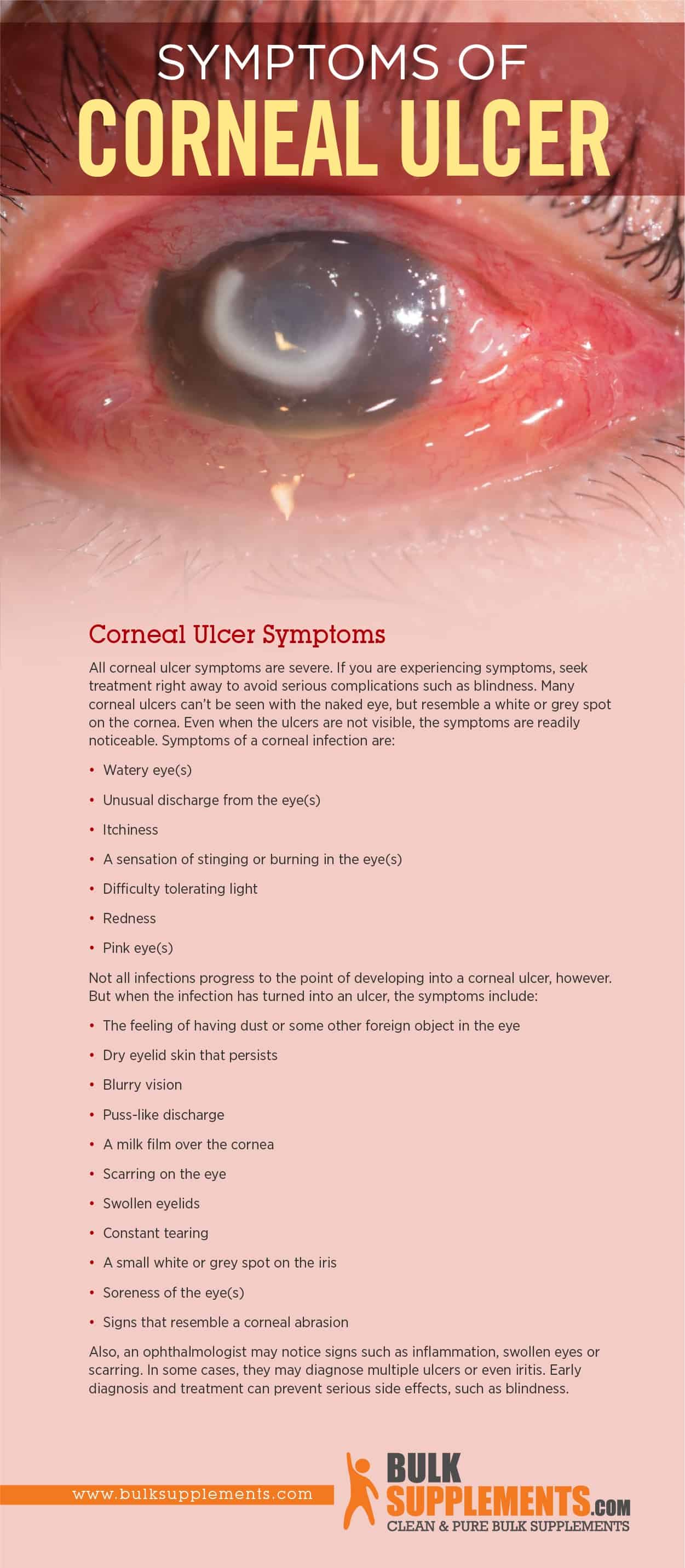Corneal Ulcer: Characteristics, Causes & Treatment
by James Denlinger Digital Marketing StrategistWhat is a Corneal Ulcer?
When you think about ulcers, you probably think about those that form in your stomach, but you can also get them in your eyes. In fact, one of the most common eye illnesses is a corneal ulcer. A corneal ulcer is a small sore that grows on your cornea. The cornea is the clear tissue that covers the front part of your eye. Your cornea allows light inside of your eye and helps your brain to process images.
In most cases, a corneal ulcer is brought about by an infection, injury or even wearing contact lenses (contact ulcers). Opportunistic pathogens like Serratia marcescens also have the potential to cause ulcers in the cornea. Eye ulcers in humans are open sores that don’t form a scab or heal naturally like sores on other parts of the body. Surface ulceration of the cornea can lead to infection or ulcers, which, if left untreated, can cause blindness.
Forms of Eye Ulcers
There are several forms of eye ulcers. A dendritic ulcer, for example, is an open sore on the eye caused by the herpes simplex virus. A perforated corneal ulcer is a more severe form of a corneal ulcer in which the cornea becomes thin. This thinning may cause a rupture of the cornea film, which will have a considerable negative impact on vision. In some cases, these ulcers can develop as a result of corneal abnormalities such as dry eye, keratoconus or others may leave the eye more prone to developing ulcers.
Corneal Ulcer Symptoms
All corneal ulcer symptoms are severe. If you are experiencing symptoms, seek treatment right away to avoid serious complications such as blindness. Many corneal ulcers can’t be seen with the naked eye, but resemble a white or grey spot on the cornea. Even when the ulcers are not visible, the symptoms are readily noticeable. Symptoms of a corneal infection are:
- Watery eye(s)
- Unusual discharge from the eye(s)
- Itchiness
- A sensation of stinging or burning in the eye(s)
- Difficulty tolerating light
- Redness
- Pink eye(s)
Not all infections progress to the point of developing into a corneal ulcer, however. But when the infection has turned into an ulcer, the symptoms include:
- The feeling of having dust or some other foreign object in the eye
- Dry eyelid skin that persists
- Blurry vision
- Puss-like discharge
- A milk film over the cornea
- Scarring on the eye
- Swollen eyelids
- Constant tearing
- A small white or grey spot on the iris
- Soreness of the eye(s)
- Signs that resemble a corneal abrasion
Also, an ophthalmologist may notice signs such as inflammation, swollen eyes or scarring. In some cases, they may diagnose multiple ulcers or even iritis. Early diagnosis and treatment can prevent serious side effects, such as blindness.
 PIN IT
PIN ITCauses of Corneal Ulcers
If you are wondering how you get an ulcer in your eye, the answer is simple — infection, in one form or another. But there are also other causes you should keep in mind:
Contact Lens
Wearing contact lenses introduces various pathogens and bacteria to your eyes regularly. In addition to the germs, the contacts themselves pose a risk of scratching the cornea and leaving your eye open to infection. Contacts that don’t fit properly or are lacking enough lubrication can rub against the surface of the eye. Repeated rubbing can cause the epithelium of your cornea to become damaged. When the outer layer is damaged, it may allow bacteria to penetrate the eye and develop into an ulcer.
Bacteria
Bacteria that enter the cornea through trauma or a random opportunity can cause ulcers. Herpes simplex or ocular herpes can cause an infection serious enough to make a person develop a corneal ulcer. The viral infection can lead to damage to the exterior layers of the eye as well as to deeper layers of the eye if left untreated.
Fungus & Parasites
Fungal keratitis is most often seen in people who wear contacts. This fungus originates from a certain type of contact lens solution that was not formulated to prevent the fungus’ growth. Although this type of contact lens solution is no longer on the market, those who wear contacts but don’t use the proper solution can still develop a corneal ulcer from this particular fungus. Fungal keratitis can also develop if an injury to the eye involves plant material.
Acanthamoeba is a common parasite that can cause severe infection. The infection has been known to cause irreversible scarring and even blindness. This parasite is most often found in public swimming pools, untreated tap water and other unfiltered water sources.
Other Risk Factors
Those who suffer from chronically dry eyes, weakened immune systems, and allergies are also more prone to developing corneal ulcers. Patients who have psoriasis and multiple sclerosis are also likely to develop eye ulcers as a side effect of their condition.
Corneal Ulcer Remedies
Medication
After the corneal ulcer has been diagnosed and the cause identified, a range of treatments may be prescribed to combat the infection. Depending on the cause, antiviral, antibacterial or antifungal eye medication could be prescribed to treat the cause of the infection. In severe cases, patients may be given antibacterial eye drops to use while an ulcer scraping culture is processed. If the eye is swollen or inflamed, corticosteroid eye drops can be used to reduce the swelling. While undergoing treatment for corneal ulcers, you should avoid wearing cosmetics in the eye area, contacts or touching the infected area.
Preventive Treatments
If you have suffered some form of physical trauma to your eye, there are ways to treat the corneal abrasion before it has a chance to develop into an ulcer. Abrasions may be a result of an accident, debris or even due to irritation from contact lenses. In the case of contact lenses, an over-the-counter antibiotic eye drop for scratched eyes could be prescribed. Scratches on the cornea can be very painful; corneal abrasion pain relief can be found by using an over-the-counter pain reliever like Tylenol or Motrin. In serious cases, topical cycloplegics or a strong oral narcotic analgesic may be needed. It’s common to experience some form of blurry vision after corneal abrasion. Once the trauma has had time to resolve, the vision should be restored.
Irrigation and Slit Microscope
If an external agent caused the corneal ulcers, you would need to have that agent removed. Treatment would involve irrigation if the agent were a chemical. But if the agent was wood or metal, you will need a slit microscope. Once the eye has been cleaned, antibiotics will be applied to help reduce corneal scarring.
Targeted Treatment
Those who suffer from specific immunological diseases will require targeted corneal ulcer treatment with immuno-suppressive drugs that match their condition. The ophthalmologist will coordinate with the patient’s other doctors to formulate a treatment plan that will best address the cause of the ulcer.
Corneal Transplants
In serious cases where medication doesn’t effectively control the ulcer, surgical abrasion may be required. Further, if the cornea has been significantly thinned and is in danger of perforation, doctors may opt to perform a keratoplasty — a corneal transplant — to save the eye. A surgical transplant is a serious procedure. The existing abnormal corneal tissue will be surgically removed and replaced with donated tissue. Though the procedure is safe, there are some possible complications to keep in mind, such as infection in the eye, glaucoma, donor cornea rejection, corneal swelling and cataracts.
Supplements for Corneal Ulcer Symptoms
Corneal ulcers are common but need proper treatment by an ophthalmologist to prevent irreversible damage. There are several supplements and natural treatments you can take at home to help reduce the symptoms of eye ulcers. Some alternative healing protocols to relieve discomfort are:
Vitamin A
When it comes to your vision, vitamin A should be at the top of your supplement list. It helps to combat damage from free radicals, reduces inflammation and boost brain health. Food sources of vitamin A are raw carrots, liver, bell peppers and sweet potatoes, among others. When taken as an external supplement, the recommended dose is 30 mg once daily along with your meal. Many eye drops can help relieve the symptoms of corneal ulcers, but they should contain vitamins E, C and A for best results.
Zinc
Zinc supplements are a great way to help your body fight infection. They help your body to reduce inflammation naturally as well as improve the way your immune system responds to health threats. You can increase your natural zinc sources by including pumpkin seeds, lamb and garbanzo beans into your diet. But if you take a zinc supplement to treat corneal ulcers, a dosage of 100 mg three times daily is suggested for optimal health.
L-Lysine
According to recent research, L-lysine is extremely helpful in the fight against viral infections. This amino acid can be found in food like lamb, tuna, eggs and parmesan cheese. As a supplement to aid in fighting corneal ulcers, take one capsule no more than twice daily for effective results.
Vitamin D
Vitamin D is one of the most important to add to your diet when you are fighting an infection. In general, a large portion of the world’s population suffers a vitamin D deficiency. This deficiency can increase the risk of developing infections, including corneal ulcers. Spend at least 15 minutes in the sun every day as well as take a supplement to help improve your immune system response.
Colloidal Silver
Colloidal silver works to bind and then kill germs in the body. When used as an eye drop, just a few drops have proven successful in fighting off various infections in the eye, including those that cause corneal ulcers. However, it’s critical that you speak with a medical professional before using this home treatment because it is known to interact with several antibiotics. This form of treatment can be used in humans and canines.
Echinacea
Echinacea has been used throughout the ages to stimulate the immune system and help the body fight against harmful viruses and bacteria. You can drink echinacea in the form of a tea or can take them as a supplement. The suggested dosage for those looking to reduce the symptoms of corneal ulcers is 450 mg no more than twice daily. It’s critical to note that echinacea increases the breakdown time of caffeine and also interacts with many antifungal medications and immunosuppressants. Speak with a medical professional before you start an echinacea regimen.
Tea Tree Oil
As far as healing oils go, tea tree oil is at the top of its class. This essential oil can help alleviate the symptoms of corneal ulcers. It has proven effective in reducing inflammation around the eye and reducing parasitic infection recurrence. The oil should not be used directly in the eye, but only on the surrounding skin.
The Bottom Line
Corneal ulcers are a common eye problem found in people of all ages. Though most often found in people who wear contact lens, anyone can develop an eye ulcer. Treatment should always be given immediately for any form of eye infection to prevent corneal ulcers from developing. And if they do, the treatment for corneal ulcers is usually aggressive and geared towards eliminating the cause of the condition. Though painful, there are many prescription and supplemental treatments available to help manage the symptoms of the disease. Over-the-counter pain relief medication will help with the pain. Also, natural supplements such as zinc, vitamins A and D and echinacea will help your body fight infection and heal itself. If you have suffered an eye abrasion or if you notice the symptoms of a corneal ulcer, seek medical attention right away to prevent vision loss.
Sponsor Ads
Created on Mar 18th 2020 20:59. Viewed 653 times.




